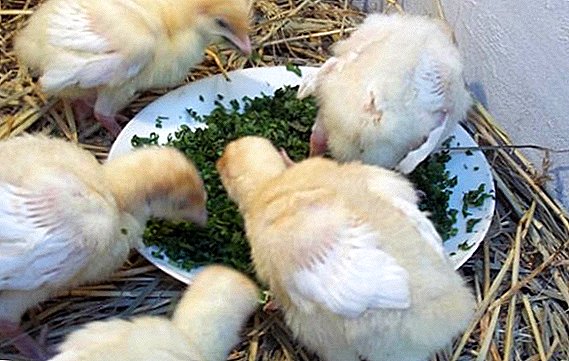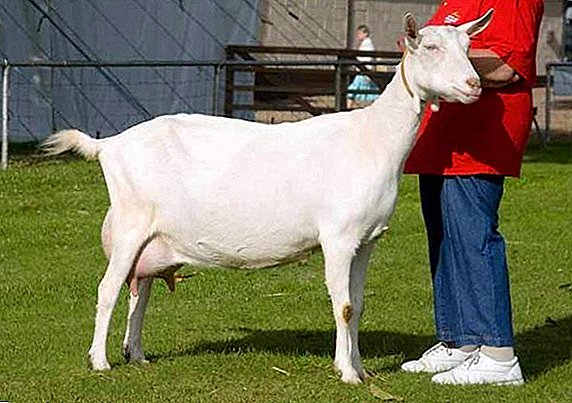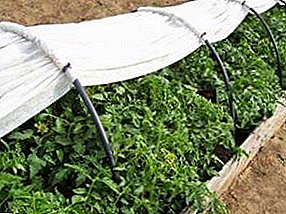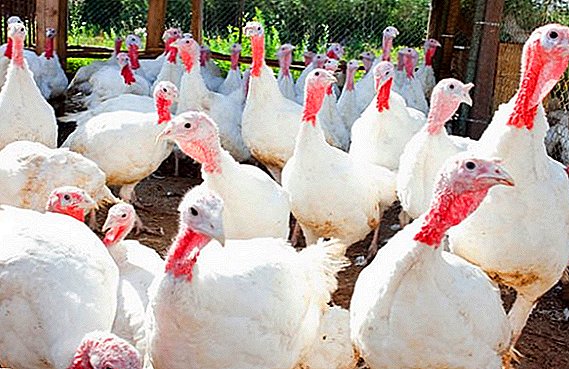 Growing turkeys is becoming increasingly popular with farmers today. And there is nothing surprising in this: the meat of these birds is tasty, and the eggs are large and healthy. To obtain these products need a healthy livestock. How to achieve a good egg production turkeys, we will tell further.
Growing turkeys is becoming increasingly popular with farmers today. And there is nothing surprising in this: the meat of these birds is tasty, and the eggs are large and healthy. To obtain these products need a healthy livestock. How to achieve a good egg production turkeys, we will tell further.
Turkey productivity
The beginning of egg laying depends on hereditary characteristics, bird weight, season and lighting. After the turkey begins to hatch the turkeys, the egg production is completed. Only certain breeds, while ensuring special conditions of detention, are able to be carried throughout the year.
Learn how to grow broiler turkeys at home.
On average, turkey productivity can be represented by such a table.
| Turkey weight, kg | Turkey weight, kg | Egg production, pieces per year | Egg weight, grams | Incubation period, days | Egg color |
| 13-16 | 7-9 | 40-90 | 70-90 | 28 | Creamy white, interspersed |

Turkey egg production by breed
Domestic breeds start laying eggs at the age of 7-8 months. However, this figure is mainly theoretical, since in practice, active laying of eggs is observed at the age of 5-6 months.
Did you know? If there are not enough turkeys, poultry farmers use turkeys as hens. They are planted on a nest and covered with a basket.
Virginian
Pure white birds, sometimes called white or Dutch turkeys. Representatives of the breed have a mediocre body size. Hatching ability retained. The mass of a mature turkey is 9 kg, females - 4 kg. The laying for the season - 60 eggs. 
North Caucasian white
The oldest domestic variety, which is perfectly adapted to walking on pastures. They have an elongated, very wide body. Plumage - thick, white. Bred mainly for the purpose of obtaining meat. Females differ from males in smaller sizes and more rare feathering of the head with a perfectly feathered neck.
We advise you to read about how to properly breed turkeys, how to treat their diseases, as well as how to distinguish a turkey from a turkey.
On average, the live weight of a turkey varies from 6 to 7 kg, the turkey - from 12 to 15 kg. Egg-laying begins at the age of 9-10 months and lasts for six months. During this period, you can get 90-160 eggs from a turkey (180) for eggs weighing 85-100 g. 
Bronze wide chest
Representatives of this breed are one of the largest turkeys. The breast area of these birds is well developed (makes up 30-35% of the carcass itself).
Read more about turkey breed bronze wide-breasted.
Live weight of males reaches 14-16 (sometimes - 18) kg. The average weight of a female is 8-9 kg. Turkey productivity is 55-70 eggs per season. The average egg weight is 80-85 g. 
Important! As chicks, these turkeys are no good - because of their impressive mass, they often squeeze chicks.
Moscow Bronze
It was bred in the Moscow region on the basis of wide-chested bronze, north-Caucasian and regional bronze turkeys. The breed stood out for its high vitality, endurance, adaptability to the range and practicality.
Live weight of males - 15-16 kg, females - 7-9 kg. The number of eggs laid - 80-90 pieces per season. The average egg weight is 85-90 g. 
BIG-9
Hardy and heavy breed, which does not require much effort when growing. They freely adapt to any conditions and are characterized by excellent meat indicators. BIG-9 combines high reproductive characteristics with rapid weight gain and low feed costs.
Did you know? Pooh breed is highly valued for its softness and lightness.
The live weight of an adult turkey - 20-21 kg, turkeys - 11-12 kg. Lays 110-120 eggs per season. 
BIG-6
The most popular breed, distinguished by excellent performance and precocity of meat, belongs to the ponderous. Representatives of BIG-6 - massive, with a modest-sized head and a stocky body. Feather cover - white, fluffy.
You will probably be interested to learn more about such breeds of turkeys as Uzbek fawn and big 6.
Adult males weigh 20–25 kg, females weigh 9–10 kg. Cease to grow at the age of 100 days. Egg laying - 90-100 pieces per season. 
Hidon
This hybrid breed came to our region at the end of the 20th century from the Netherlands. It is characterized by a quick weight gain. The average weight of turkeys is 18-20 kg. The productivity of females - 90-100 eggs per season.
Tikhoretskaya black
This hybrid was obtained in the Krasnodar Territory (Tikhoretsky District) from regional black turkeys. Representatives of the breed have black plumage with an interesting bronze brilliance. Differ in maneuverability. The weight of a live male is 9.5-10 kg, turkeys 4.5-5 kg. Egg production - 80-100 eggs weighing 80-85 g.
Important! Breed is suitable for cellular cultivation.

Uzbek fawn
A variety has been developed due to the careful selection of Uzbek indigenous turkeys, the authorship belongs to the poultry farmer N. Zolotukhin. The breed is perfectly adapted to Asian conditions; therefore, it is most common in Uzbekistan, Tatarstan and the North Caucasus region.
We recommend reading about the beneficial properties of meat and turkey liver.
The disadvantages of the breed include:
- slow weight gain;
- low egg production;
- relatively low quality meat.

Among the pros note simplicity to feed. The torso of a bird is a medium, rather impressive species. The head is small, from the side it seems to be narrowed. The plumage is red-brown (hence the name is pale-yellow). Adult turkeys weigh 9-10 kg, females - 3.5-4 kg. For one cycle turkey produces 60-65 eggs.
Important! If the turkeys do not have enough calcium, they will spit eggs or lay them altogether without the shell.
How to increase turkey egg production
It happens that quite healthy birds, which have already reached the age of egg production, do not start laying. In this case, additional lighting should be installed. In this way, activation of the spermatogenesis process in males and females begins to be carried earlier.  However, turkey egg production depends on such factors:
However, turkey egg production depends on such factors:
- weight and breed;
- day length at least 10 hours a day. The best option - 13-17 hours;
- quality and volume of feed - it must contain the optimal amount of mineral elements and vitamins;
- comfortable conditions - the hen should be warm and dry. In cold weather, it is necessary to maintain the temperature of + 12 ... +16 ° C and relative humidity - 60-70%;
- fresh air - the room should be well ventilated;
- the bird must be restrained from stress - in the turkey he should maintain peace and quiet.
Important! One shelter is enough for 4-5 turkeys

Tips from farmers
Experienced poultry houses offer some tips for beginners how to behave during the laying of eggs:
- On the eve of the start of egg laying, it is important to create suitable conditions. So, in the aviary the temperature should not be maintained below +10 ° C.
- It should also pre-equip the nest. To do this, you can use a wooden box (parameters - 50x70x60 cm) with dry ground, and lay a bed of dried grass on the bottom. In this case, the nest should be placed in the most peaceful corner of the room.
- Approximately 30 days before laying, it is recommended to gradually increase the daylight due to auxiliary light sources, so that by the beginning of the laying of eggs it was 13-17 hours.
- Birds actively lay eggs from 11 to 15 hours, but occasionally it happens at 8 am. Therefore, it is recommended to walk turkeys either early in the morning, or after 16:00. Ignoring walks is not worth it - it can affect productivity.
- Layers spend a lot of energy, so you need to feed them up to five times a day. In the feed necessarily include grains containing fiber and carbohydrates. In addition, the diet should be juicy food (carrots, clover, cabbage, alfalfa, softened).
- Since the laying begins in early spring (and fresh greens are not yet found at this time), chopped needles are added to the feed. And for the autumn laying in the summer, the nettles, grass and foliage of birch are harvested.
 In conclusion, we note that by providing the turkeys with favorable conditions, a clean room and the necessary amount of food, mineral components and vitamins, it is possible to get not only tasty meat, but also healthy eggs, and healthy chicks.
In conclusion, we note that by providing the turkeys with favorable conditions, a clean room and the necessary amount of food, mineral components and vitamins, it is possible to get not only tasty meat, but also healthy eggs, and healthy chicks.It will be useful for poultry farmers to read about how to raise turkeys in an incubator, what should be the temperature regime for turkeys, how much turkeys and adult turkeys weigh, and how to treat diarrhea in turkeys.
Do not forget about the rest and walks in which the hens need no less.
Reviews from the network
For high quality turkey eggs, greens, cereal products, as well as food enriched with calcium and protein should prevail in the poultry diet. Balanced nutrition is most needed in the pre-selection period: January-April.














